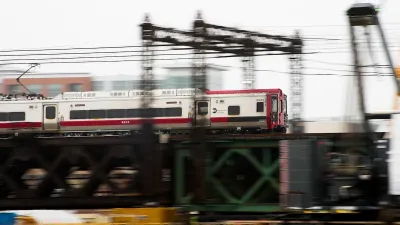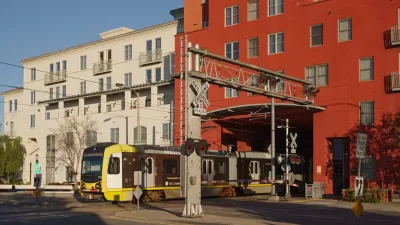The ‘Work, Live, Ride’ bill would prioritize funding for designated transit-oriented zones to encourage denser development near transit.

A bill that would encourage more transit-oriented development is back before the Connecticut State Assembly, reports Sam Hilton in Connecticut Mirror.
Dubbed Work, Live, Ride by the housing advocacy group DesegregateCT, this measure would prioritize communities with qualifying transit-oriented districts when doling out discretionary infrastructure funding or grants such as the Small Town Economic Assistance Program (STEAP) or the Urban Act Grant Program, both of which help municipalities invest in economic revitalization.
The law defines transit-oriented districts as “an area within a half-mile radius of a train or bus station that a city or town has designated for mixed-use and more dense development.” The zones would permit middle housing such as duplexes as well as higher-density multifamily housing.
Notably, this new version of the bill allows “transit-adjacent” communities without their own transit stations to create their own transit-oriented districts as well. The updated bill would create a public water and sewer rehabilitation or expansion account to assist communities with improving their infrastructure to accommodate new development.
Opponents say the law could force cities into zoning changes without community input. Hilton notes that the bill doesn’t force cities to create transit-oriented districts, but “specifies that a city must ask the secretary to designate such an area as qualifying for priority funding at a state level, and that areas that are already sufficiently dense can be grandfathered in at the town’s request, but don’t have to be.”
FULL STORY: ‘Work Live Ride’ is back on the legislature’s docket. Here’s what to know

Alabama: Trump Terminates Settlements for Black Communities Harmed By Raw Sewage
Trump deemed the landmark civil rights agreement “illegal DEI and environmental justice policy.”

Planetizen Federal Action Tracker
A weekly monitor of how Trump’s orders and actions are impacting planners and planning in America.

The 120 Year Old Tiny Home Villages That Sheltered San Francisco’s Earthquake Refugees
More than a century ago, San Francisco mobilized to house thousands of residents displaced by the 1906 earthquake. Could their strategy offer a model for the present?

In Both Crashes and Crime, Public Transportation is Far Safer than Driving
Contrary to popular assumptions, public transportation has far lower crash and crime rates than automobile travel. For safer communities, improve and encourage transit travel.

Report: Zoning Reforms Should Complement Nashville’s Ambitious Transit Plan
Without reform, restrictive zoning codes will limit the impact of the city’s planned transit expansion and could exclude some of the residents who depend on transit the most.

Judge Orders Release of Frozen IRA, IIJA Funding
The decision is a victory for environmental groups who charged that freezing funds for critical infrastructure and disaster response programs caused “real and irreparable harm” to communities.
Urban Design for Planners 1: Software Tools
This six-course series explores essential urban design concepts using open source software and equips planners with the tools they need to participate fully in the urban design process.
Planning for Universal Design
Learn the tools for implementing Universal Design in planning regulations.
Clanton & Associates, Inc.
Jessamine County Fiscal Court
Institute for Housing and Urban Development Studies (IHS)
City of Grandview
Harvard GSD Executive Education
Toledo-Lucas County Plan Commissions
Salt Lake City
NYU Wagner Graduate School of Public Service





























